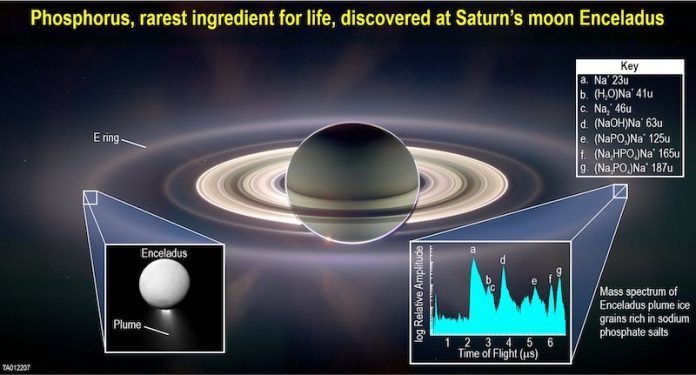
Scientists have found new clues that hint at the presence of life on Enceladus, one of Saturn’s moons.
The key to this discovery: Phosphorus, an essential building block of life as we know it on Earth.
A team of researchers, including Dr. Christopher Glein from the Southwest Research Institute, detected phosphorus on Enceladus.
They used data from NASA’s Cassini mission, which studied Saturn and its moons for over a decade.
What’s Special About Phosphorus?
On Earth, phosphorus is found in everything from our DNA and cell membranes to our bones and teeth. Without it, life as we know it wouldn’t be possible. This makes the detection of phosphorus on Enceladus extremely exciting.
Dr. Glein, an expert in studying oceans on other planets, said that the team found phosphate concentrations on Enceladus that are at least 100 times higher than in Earth’s oceans. This discovery is a significant step forward in the search for life beyond Earth.
What Else Did We Learn?
Cassini had previously found out that Enceladus has a subsurface ocean, hidden beneath its icy surface. This ocean sprays out ice grains and gases into space, which Cassini was able to analyze.
The data showed the presence of sodium phosphates, suggesting that phosphorus is readily available in Enceladus’ ocean.
The team also believes that Enceladus’ ocean interacts with its rocky core in a way that promotes the dissolution of phosphate minerals. This means phosphates could be available to any potential life in the ocean.
What’s Next?
In the past 25 years, scientists have learned that many worlds in our solar system have oceans beneath layers of ice. This includes other moons like Europa and Titan, and even distant bodies like Pluto.
These icy ocean worlds could exist across a wider range of distances from their host stars than Earth-like worlds, increasing the number of potentially habitable places.
Dr. Glein said that Enceladus now meets the strictest requirement for life as we know it. The next step, he said, is to go back to Enceladus and see if its habitable ocean is actually inhabited.
The study was published in Nature.
Copyright © 2023 Knowridge Science Report. All rights reserved.



